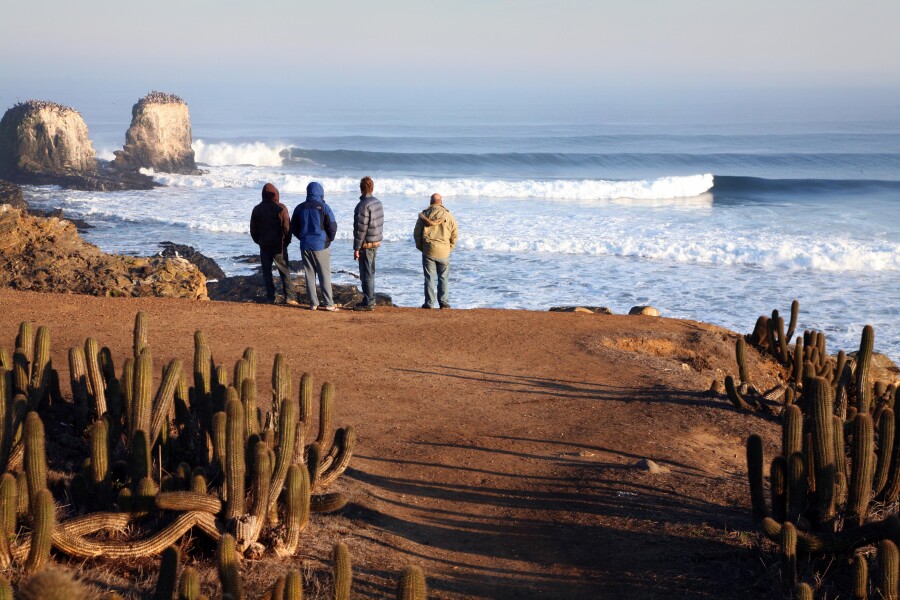Since 2009, the World Surfing Reserves conservation initiative has been proactively protecting precious coastal resources around the world. Created and managed by Save The Waves Coalition, the program works in partnership with local communities to maintain a growing number of the most spectacular seaside locations on the planet, from the United States to Australia to Europe and beyond—think of the program as the UNESCO for surfing. And much like UNESCO sites, the motivation behind the designations is to protect the very things that make each location so compelling. Spanning four continents, the reserves are iconic places that harbor a remarkable combination of natural beauty, marine wildlife, cultural heritage, and yes, great surfing waves. These are places you want to visit, surfer or not.
Here’s a quick rundown of three of the reserves—Santa Cruz, California, Punta de Lobos, Chile, and Ericeira, Portugal—along with what makes them so cool.
Santa Cruz, CaliforniaThere’s a reason wetsuit and surfing icon Jack O’Neill set up shop in Santa Cruz back in the early 1960s, and it’s the same reason a seven-mile stretch of coast here was approved as a World Surfing Reserve in 2011. “Santa Cruz is a treasure trove of surf spots for all abilities,” says Nik Strong-Cvetich, executive director of Save The Waves Coalition. “It’s located within the Monterey Bay National Marine Sanctuary, so there is a ton of flora and fauna in the water. It also happens to be the first place that surfing happened in North America, so it has a long history of surf culture.” This will come as no surprise to any who have relished the area’s laid-back lifestyle, sunny beaches, and bountiful sea life. Whales, dolphins, sea lions, otters, and even the occasional shark all commonly share the waters with wetsuit-clad surfers, paddlers, and swimmers. And for anyone who wants to give wave riding a shot, make sure this destination is on your list: Cowell Beach, next to the Santa Cruz Wharf, is heralded as one of the best beginner surf spots in the world.
Activities led by Save The Waves have helped reduce water bacteria at Cowell Beach by 50 percent in the past two years, removing it from the top spot on the environmental nonprofit Heal the Bay’s “Beach Bummer List,” where it previously sat for three years. That means cleaner water for both humans and sea life at Cowell’s and at surrounding beaches.

Ribeira d’Ilhas, Ericeira, Portugal.
Photo by Adamina/Flickr
Punta de Lobos, Chile
The large headland at Punta de Lobos on the central coast of Chile was approved as a World Surfing Reserve in 2013. Two giant “morros” (“noses”), looming over 100 feet tall, distinctly mark the tip of the iconic point, which is not only an international surfing mecca, but also a hot spot for marine and terrestrial biodiversity. Upwelling from the Humboldt Current brings cold, nutrient-rich water to the region and attracts numerous species of whales, orcas, sea lions, penguins, sea turtles, and more. It’s also a magnet for a variety of seabirds. On the point itself are a number of endemic plant species, most notably a rare cactus (Echinopsis bolligeriana), which lives in only two locations in Chile and is on the International Union for Conservation of Nature’s Red List of threatened plant species.
Chilean big-wave surfer Ramón Navarro, the son of a local fisherman, literally grew up on the sand at Punta de Lobos and has been instrumental in its ongoing protection. “Traveling around the world searching for waves, I saw a lot of places that had been ruined by pollution and uncontrolled development,” says Navarro. “I was determined to not let the same thing happen here at Lobos.”
Using the Reserve as a vehicle and working with local partners, key portions of land have been purchased and placed in a conservation land trust, providing permanent, legal protection from development. It is now the first conservation land trust specific to a surfing area in the world.
Ericeira, Portugal
Over on the European continent, tucked away on the coast just 22 miles northwest of the capital, is Ericeira, Portugal, long a premier destination for surfers in the know. More recently, however, travelers of all types have begun discovering the region. Ribeira d’Ilhas, home to a professional world tour surfing event, serves as ground zero for surfers and beach-goers, but there are dozens of world-class beaches and surf spots to explore in the area. A strong lineage of artisanal fishing supplies local restaurants with some of the best seafood in Europe, and the quirky waterfront village of Ericeira provides a unique combination of Old World charm fused with modern beach culture. Its many pedestrian-only streets are ideal for leisurely strolling at any time of day.
“Surfer or not, if you enjoy the ocean, Ericeira is an amazing place,” says João de Macedo, Portuguese professional big-wave surfer and World Surfing Reserves ambassador. “The beaches are beautiful and there’s a lot of variety, including waves for all surfing levels—from super gnarly reef breaks to soft, mellow pointbreaks.”
The Reserve at Ericeira, which features 2.5 miles of pristine coastline and beaches, spawned an innovative, first-of-its-kind interpretation center that opened in 2016. The center uses detailed data visualization to present and explain the characteristics of the Reserve, including the seven main surf breaks, the biosphere, the meteorological composition, the flora and fauna, and the facilities.
Currently, there are nine World Surfing Reserves, including Malibu, California; Manly Beach, Australia; Huanchaco, Peru; Bahia Todos Santos, Baja Mexico; Gold Coast, Australia; and Guarda do Embaú, Brazil. As the World Surfing Reserves program continues to expand, efforts are underway around the world to protect special coastal regions, using surfing as the lens.











